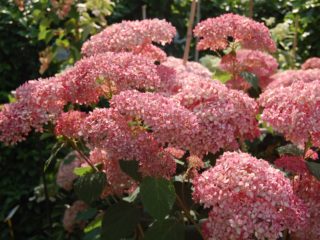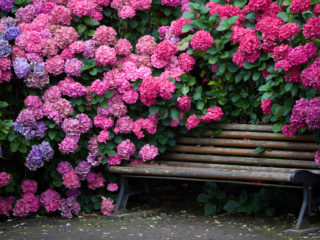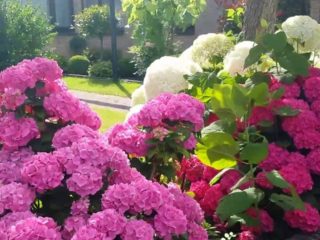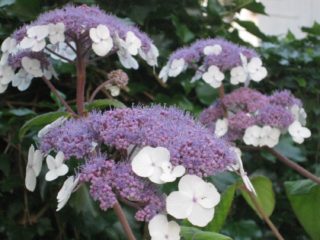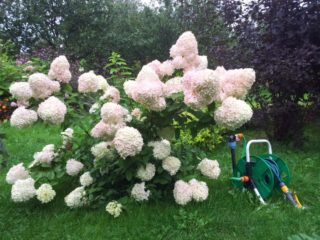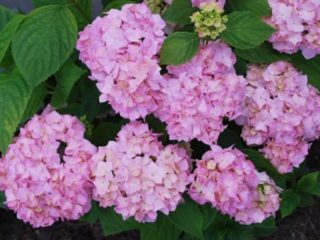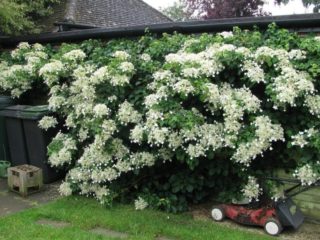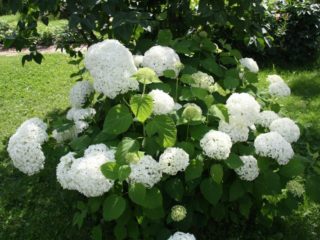Content
Hydrangea Chameleon is a popular garden shrub that has the rare ability to change the color of its inflorescences. There are many reasons why this happens. Professionals have been studying this issue for a long time. Chameleons bloom in shades of blue, pink and purple. Growing a shrub is very difficult, the reason is difficult care. To enjoy the beauty of hydrangea, you need to take into account the advice of experienced gardeners.
Description of hydrangea variety Chameleon
“Chameleon” is an ornamental shrub, the birthplace of which is considered to be Far Eastern Europe. The plant can reach a height of 1 to 3 meters. Only competent care is the key to the long-term attractiveness of the Chameleon.
Most plants bloom best in partial shade, but some tolerate full sun. Flowering time is summer, some hydrangeas are earlier and others are later.
In order to form flowers of a certain shade, you can water them with alum.The result is that pink hydrangea produces blue, and red bush produces purple. You can get a blue plant by digging rusty nails into the soil.

If you water a bush with a solution of manganese, the inflorescences may change color from pink to blue
Hydrangea variety Chameleon in landscape design
Hydrangea is used for:
- path framing;
- hedges;
- creating bright and colorful corners in the shade of the garden;
- as a neighbor for hosta and fern.
In winter, “Chameleon” is put away in basements or greenhouses. You can also continue growing indoors in flower pots.
"Chameleon" is one of the main plants of a beautiful garden. Proper care will help preserve the shrub for a long time.
Hydrangea should not be planted next to yellow and red flowers.
Blue inflorescences can be obtained as follows:
- Create an acidity level of 4 to 4.5.
- Add aluminum ions to the soil.
When the pH reaches 6, the hydrangea will turn pink. A value above 7 can be detrimental to the plant.

The plant prefers to grow in partial shade
Winter hardiness of hydrangea variety Chameleon
Hydrangea tolerates cold well, but in areas with harsh winters it is always possible to plant the plant in containers and decorative containers.
Preparatory work before winter cold:
- Reduce watering in late summer.
- Insulation of roots (using spruce branches, sawdust, tree leaves or special material).
- Mulching the soil (the layer is able to protect the roots from severe frosts).
- Bending the stems to the ground.
Simple measures will help preserve the Chameleon during severe frosts. Growing hydrangeas is a simple, but very responsible process. Beautiful flowers can only be obtained if all conditions are met.

Hydrangea tolerates severe frosts relatively well
Planting and caring for Chameleon hydrangea
"Chameleon" can grow and bloom in a slightly darkened place, protected from gusts of wind. The soil should be slightly oxidized. Red high-moor peat or spruce remains are mixed with leaf humus. When planting seedlings, the composition is added to the hole. Plants will require constant watering throughout the season.
Selection and preparation of a landing site
The best place for Chameleon is in an area in the garden that receives morning sun and afternoon shade. When choosing, it is important to consider the size of the hydrangea - the plant needs a lot of space to grow. An area of the garden that has excellent drainage works well. If necessary, you should replenish the soil with compost. Hydrangeas should not be planted under trees—root competition and lack of sunlight will not allow them to thrive.
Landing rules
Cultivation begins successfully with the planting process. Hydrangeas purchased in containers should be planted in spring or fall.
Hydrangea is photophilous, so it prefers sunny places, but can also grow in partial shade. The best time for planting in spring is the first half of May, in autumn - September.
Planting holes are dug 50x50x60 cm in size at a distance of 1-1.5 m from one another.
Composition of the soil mixture:
- humus;
- leaf soil;
- peat;
- sand;
- fertilizers
The ratio is 2:2:2:1:1.
The rooting of large-leaved hydrangea Chameleon is presented in the video:
Landing rules:
- You cannot plant the plant under trees (the roots absorb nutrients from the soil, the hydrangea will lack nutrients).
- Too aggressive sun is not suitable for "Chameleon", this leads to rapid drying of the soil (also flowering will begin much later).
- The roots need to be trimmed a little.Advice! The root collar should not be planted deep.
- The distance between bushes is at least 1 meter.
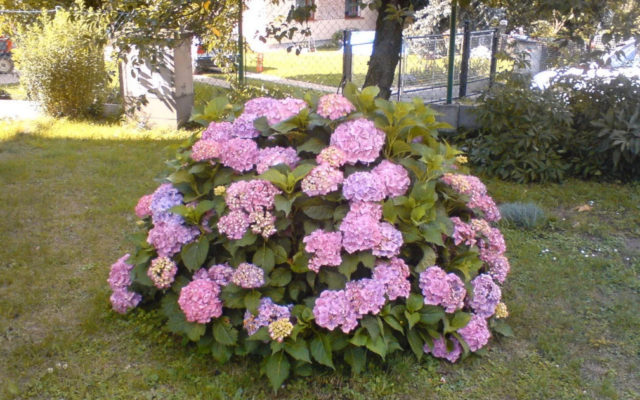
The optimal period for planting is May and September
Landing algorithm:
- Prepare the pit. Its size depends on the number of roots the seedling has. The required depth is 50 cm, length and width are 75 cm.
- Place crushed stone and sand at the bottom of the hole. Black soil is added on top; it should be larger than the other components.
- Place the Chameleon in the center of the pit. The neck can be deepened only 3 cm.Important! The roots need to be spread along the bottom.
- Cover the seedling with soil.
- Water the plant thoroughly.
- Add more soil; it is important to compact it thoroughly around the bush.
Compliance with the conditions will help to grow an adult and spreading bush. If you do not provide the Chameleon with suitable soil, it may die.
Watering and fertilizing
The main function of feeding is to provide the Chameleon with nutrients. This is necessary for normal development and growth.
What does the procedure give:
- obtaining flowers and buds;
- saturation of the soil with micro- and macroelements;
- long and intense flowering.
Universal fertilizing: nitrogen, potassium and phosphorus.
Hydrangeas like moderate humidity. Container plants require daily watering.
Feeding rules:
- If a soil mixture was used during planting, then fertilizer is not needed for the first 24 months.
- During the period when buds appear, add 80 g of superphosphate and 50 g of potassium sulfate.
In summer, “Chameleon” is fed with mullein solution (1:10).

Fertilizers must be constantly applied for plant growth and flowering.
A way to improve soil aeration is to add coarse sand. "Chameleon" does not like heavy and loamy soil, this leads to waterlogging.
Ways to protect against oxygen deficiency:
- periodic loosening;
- mulching (carried out at the base of the bush).
Soil permeability is the main condition for growing a beautiful plant. You can improve the properties of the soil by adding peat or sand. This will allow the liquid to flow more easily to the root system.
It is best to use rainwater to water hydrangeas. Tap water is a bad option. The right time for watering is morning or evening. The amount of liquid per bush is 2 buckets.
Pruning Chameleon hydrangea
Hydrangeas do not require extensive pruning. They just need to be kept in order by removing old flowers and dead stems, thereby improving the structure and shape of the bush. The result is the penetration of sunlight and air.
Pruning hydrangeas is necessary, it gives fullness and a luxurious appearance. Improper pruning of Chameleon can slow down the flowering process. First of all, it is important to prune crooked branches, then shoots from last season.
How to prepare Chameleon hydrangea for winter
It is believed that hydrangea is a whimsical flower that needs shelter for the winter to protect flower buds. This only applies to large-leaved plants. Others may spend the winter uncovered in the middle regions of the country.
You should not trim hydrangeas that have bloomed; it is advisable to do this in the spring. Thanks to this, it is possible to preserve the kidneys located below. Under the weight of snow that accumulates on the flowers, the stems may simply break.
In late autumn, it is advisable to prune dry flowers that will definitely not survive the winter. Fallen leaves should be removed and burned.
Reproduction
Hydrangea can be propagated by cuttings, layering and dividing the bush. The grafting method using seeds is also possible, but is used extremely rarely.
Hydrangea propagation:
- By layering – shoots no older than a year are bent to the ground and dug in so that about 20 cm remains on the surface; the next season, the rooted shoot is separated from the mother plant and replanted.
- By division – the bush is dug up and divided into several parts, and each must have a renewal bud.
- By cuttings – carried out in April-June, annual shoots 10-12 cm long are cut from the bush, the leaves are removed in their lower part, and the shoot itself is treated with a growth stimulant, the final stage is that the cuttings are planted in a greenhouse or greenhouse, and after a year - in open ground.
Diseases and pests
Hydrangeas are generally not susceptible to serious disease or insect problems. 'Chameleon' is susceptible to some bud diseases, bacterial wilt, leaf spot or mildew.
Chlorosis has a number of symptoms:
- leaf lightening;
- loss of usual color.
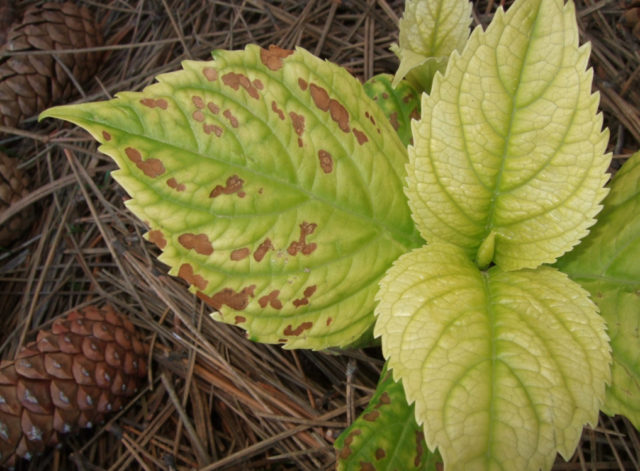
Chlorosis appears due to metabolic disorders in the plant
The cause of development is considered to be excessive humus content. The way to eliminate the problem in hydrangea is to water it with a solution of copper sulfate (with the addition of soap).
Powdery mildew occurs due to excess moisture. Aphids can be removed using garlic infusion. It is prepared as follows: 200 g per bucket of water. "Chameleon" should be watered for 7 days. During this time, the aphids will completely disappear.
Conclusion
Hydrangea Chameleon is the leader among flowers.The plant has been pleasing gardeners for a long time; its various shades attract the attention of others. "Chameleon" is often used in landscape design. Hydrangea is very easy to care for; the main thing is to follow the recommendations of professionals.
